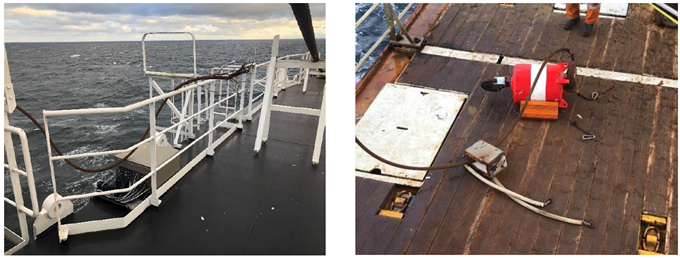Crane whip line parted during hook stop testing
What happened
The crane was positioned in the rest while the Crane Operator carried out hook stop testing of the auxiliary winch. An uncontrolled hoisting movement resulted in the headache ball striking the jib and falling with the hook stop rigging assembly back to deck.
The Crane Operator was testing both the main winch and the auxiliary winch. The main winch was tested and operated normally. When the Crane Operator started to test the auxiliary winch, the winch accelerated to full speed pulling the headache ball into the sheave. The headache ball collided with the jib and the wire snapped, approximately 19 meters from the headache ball. The headache ball (500kg) and the hook stop rigging (25kg) dropped 4.2 meters to deck. There were no personnel in the vicinity.

What went wrong?
- The winch was actuated by two hydraulic motors and the speed of the motors measured by encoders. The encoders were badly corroded inside and within the circuit board which resulted in erroneous signal being sent. Both speed encoders required replacement. The crane software was updated to include a second barrier preventing wrong signals from the encoder;
- The winch wire was in poor condition, corroded and dry. The investigation identified deviations from the wire rope management requirements of both the company and the owner of the vessel;
- The auxiliary winch wire was the original wire installed on the winch and had been in service for approximately 7.5 years. Magnetic Rope Tests (MRT) were performed every second year with wire cut-back completed in accordance with the recommendations from the examination. The latest MRT was not completed successfully due to failure in the test equipment and was overdue at the time of the incident. The wire used was 2160 grade which is vulnerable to brittleness; the company does not accept this grade if it is avoidable;
- The risk for using the wire had been identified however, it was not supported by a Management of Change (MoC) and risk assessment and so no corrective action taken.
Actions
- Check and see if this same encoder component fault can occur on your worksite and check the maintenance routines for encoders;
- Further asssure the integrity of wire ropes by carrying out a thorough visual examination combined with either annual Destruction Test or MRT Traces;
- Identify the age of the wire ropes and confirm appropriate in-service reviews have been carried out;
- Ensure formal MoC process is followed where compliance with existing procedures is not possible;
- Review risk assessment for the crane start-up process and ensure that safe positioning of personnel and associated controls are an included control requirement.
Members may wish to review: SEL 019 Guidelines for lifting operations
Safety Event
Published: 11 February 2021
Download: IMCA SF 05/21
IMCA Safety Flashes
Submit a Report
IMCA Safety Flashes summarise key safety matters and incidents, allowing lessons to be more easily learnt for the benefit of all. The effectiveness of the IMCA Safety Flash system depends on Members sharing information and so avoiding repeat incidents. Please consider adding [email protected] to your internal distribution list for safety alerts or manually submitting information on incidents you consider may be relevant. All information is anonymised or sanitised, as appropriate.
IMCA’s store terms and conditions (https://www.imca-int.com/legal-notices/terms/) apply to all downloads from IMCA’s website, including this document.
IMCA makes every effort to ensure the accuracy and reliability of the data contained in the documents it publishes, but IMCA shall not be liable for any guidance and/or recommendation and/or statement herein contained. The information contained in this document does not fulfil or replace any individual’s or Member's legal, regulatory or other duties or obligations in respect of their operations. Individuals and Members remain solely responsible for the safe, lawful and proper conduct of their operations.
